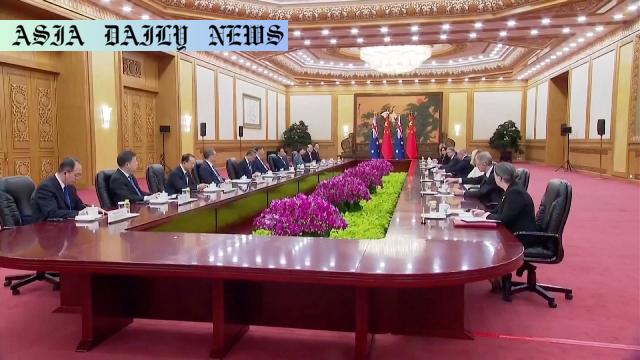Bilateral Ties: Albanese and Xi agree to foster a cooperative and open dialogue, strengthening ties amidst changing global dynamics.
Australian PM Albanese met Chinese President Xi Jinping during a six-day visit.
Both leaders agreed on strengthening bilateral ties via cooperation and dialogue.
Albanese addressed concerns over Chinese navy’s exercises in the region.
China remains Australia’s largest trading partner despite geopolitical tensions.

Building Stronger Bilateral Ties: A Key Objective
Australian Prime Minister Anthony Albanese’s six-day diplomatic visit to China marked a significant milestone in the evolving relationship between the two nations. During his meeting with Chinese President Xi Jinping on Tuesday, both leaders expressed their mutual commitment to strengthening bilateral ties. In an era of rising global tensions and shifting alliances, this dialogue serves as a refreshing and vital step towards fostering stability and collaboration.
Xi highlighted that the cornerstone of a well-functioning bilateral relationship lies in mutual respect, equality, and the willingness to understand differences while capitalizing on shared interests. He emphasized that enhancing cooperation would benefit not just the nations involved but also their people, underscoring the importance of a pragmatic, forward-looking approach. From trade partnerships to regional concerns, this meeting reflected the ambition of two powerful countries to find common ground amidst uncertainties.
Economic Partnership: A Cornerstone of the Relationship
China continues to be Australia’s largest trading partner, with bilateral trade exceeding hundreds of billions of dollars annually. Despite past diplomatic hurdles, both leaders reaffirmed the importance of keeping trade routes open and fostering economic partnerships that align with their national interests. For Australia, exports such as minerals and agriculture remain vital, while Chinese investments provide a critical boost to infrastructure and innovation sectors.
The dialogues also acknowledged the ongoing impact of trade tariffs and sanctions, particularly with shifts in global economic policies, including those initially driven by former U.S. President Donald Trump. By committing to an open and constructive dialogue, Albanese and Xi set a positive tone for resolving disputes amicably while working towards shared prosperity.
Addressing Security Concerns: A Candid Conversation
During the discussions, Albanese raised concerns about the Chinese navy’s live-fire exercises near waters between Australia and New Zealand. The exercises, conducted earlier in February, had sparked debates over regional security and sovereignty. In response, Xi provided assurances that such exercises are routine, with both nations undertaking similar military preparations.
While these reassurances reflect transparency, they also underline the importance of dialogue in preventing escalation or misunderstandings. Both leaders recognized the need for multilateral approaches to security concerns, emphasizing that stability in the Indo-Pacific is in the interest of all stakeholders.
Calm, Consistent Diplomacy: The Australian Approach
Albanese underscored Australia’s dedication to a calm and consistent diplomatic approach, rooted in its national interest. He emphasized how fostering trust and a steady hand in foreign relations plays a key role in maintaining long-term partnerships. Such an approach is vital as Australia seeks to balance ties between China, a critical trading partner, and its traditional allies such as the United States.
This stance resonates with broader global diplomatic trends where pragmatism outweighs ideological divisions. By prioritizing collaboration over confrontation, Albanese’s administration hopes to secure economic benefits while addressing geopolitical concerns in a responsible, measured manner.
The Path Forward: An Evolving Alliance
As the meeting concluded, both leaders committed to maintaining an open line of communication. This dialogue serves as a positive signal to the global community that Australia and China are willing to rise above differences for the sake of mutual benefit. With geopolitical landscapes continuously evolving, their shared determination to prioritize dialogue can pave the way for a stronger alliance.
Observers remain optimistic that the outcomes of this meeting could set a precedent for resolving larger global and regional challenges through cooperation. By addressing immediate concerns while laying the groundwork for future collaboration, Albanese and Xi have initiated what could be a new chapter in Sino-Australian relations.
Commentary
A Promising Step Forward
The recent meeting between Australian Prime Minister Anthony Albanese and Chinese President Xi Jinping presents a promising shift towards enhancing bilateral ties. Amid an era marked by stark geopolitical tensions, this dialogue signifies a commitment to reaffirming the value of diplomacy and shared interests. The mutual promise of fostering cooperation sets a hopeful precedent for managing differences in an increasingly divided world.
China is not only Australia’s largest trading partner but also a significant player in global economic and political discussions. This reality magnifies the importance of a steady, respectful bilateral relationship. By focusing on clear communication and transparency, both sides have showcased the potential for resolving disputes constructively, an example worth noting for other nations grappling with similar challenges.
Finding Balance in Challenging Times
One of the more commendable aspects of this meeting was Australia’s calm and consistent diplomatic approach. Albanese’s stance reflects a recognition of the delicate balancing act required to maintain strong ties with China while holding firm on national and regional priorities. Issues such as regional security, especially regarding naval exercises, are sensitive topics. Yet, addressing them candidly illustrates a trust-building process that bodes well for future engagements.
From a broader perspective, this evolving relationship demonstrates how nations can find common ground despite evident differences in governance and policies. It shows diplomacy’s ability to transcend divides, especially when driven by mutual respect and proactive engagement.
Opportunities for Growth
As this new chapter unfolds, it will be interesting to observe how the commitments made during this meeting are realized. Adherence to mutual respect and cooperation could bring substantial economic and strategic benefits for both nations. However, the path forward will require ongoing effort, as the global political climate continues to shift rapidly.
Overall, the Albanese-Xi meeting is a beacon for constructive diplomacy, representing the possibilities for a pragmatic and positive relationship in a world fraught with uncertainties. The emphasis on dialogue and collaboration may pave the way for a stronger and more resilient partnership between Australia and China.


